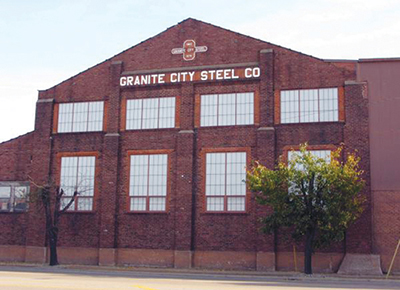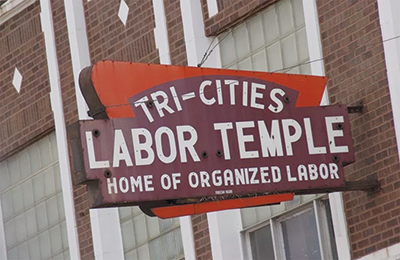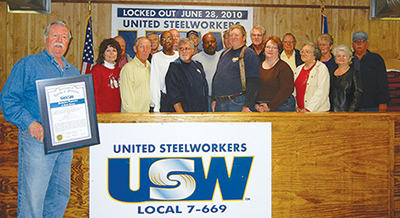The mill town where Labor ruled
A look at Labor’s glory days in Granite City
By GARY GAINES
Steelworkers Historian

Granite City, IL – In other towns around the country, the mill owners defeated the unions, took control of the factories and ran their cities and towns through their local governments.
Businesses and merchants allied with the mill owners. When workers tried to strike for better wages and conditions, they were denied credit. Governments passed laws against strikers, blacklists were created, spies were sent into the union ranks, and union members were fired to keep them out of the mills.
Even police and state militias were used against union members. But not in Granite City.
While the Amalgamated Association of Iron, Steel and Tin Workers Lodges began to disappear around the rest of the country, Lodge 11 in Granite City went from 350 members in 1900 to over 500 by 1902.
By 1910, it had grown to 750 members and, within a few more years, to 1,000 members – and there were NO Lodges remaining in the vast U.S. Steel empire.
In 1917 the national convention of the Amalgamated was held in Granite City – using a movie theater as its meeting place.

A COMMON INTEREST
The other steel mills and factories here unionized with little interference from owners and management. Everyone seemed to understand there was something different here in Granite City.
Unlike other industrial barons, brothers William and Frederick Niedringhaus, who established a steel mill and stamping and enameling factory here in 1892, recognized that their factories needed skilled workers and decided to work with unions instead of trying to destroy them. Employees organized as early as 1899, and the unions grew from there.
We had a common interest in success for the companies and the workers. Looking back on my memories, I can only remember one nasty labor dispute in this town in my lifetime.
Union organization did not stop at the plant gates but continued into the community.

In 1900, unionists formed the Tri-City Central Trades and Labor Council, a coalition of unions (not just Steelworkers) from the surrounding area, headed by a member of Amalgamated Lodge 8. The Council later merged into the Greater Madison County Federation of Labor.
The Tri-City Council began its first meeting with seven member groups, by 1908 had 29 members and by 1919, it had 59 affiliated local unions in what was called “Little Pittsburgh.”
They didn’t just organize in factories. They helped the retail clerks – the women – in the stores in town get unionized. At the NESCO stamping plant, Lodge 8 went out on a limb to help female workers win an eight-hour day, something that almost never happened in other mills and factories and that other unions didn’t bother with.
In 1907, the Council formed the Woman’s Trade Union League. Basically, if it had two legs and breathed, someone tried to sign it up in the union.
POLITICAL POWER
Originally, the Niedringhauses and their associates controlled the political organization of the town. This changed around 1900 when the Amalgamated started to become more than just a power in the mill. First they ran some candidates for office in 1901 and 1902.
In 1903, the poop hit the fan. Mayor Rosenburg was declared openly to be an enemy of workingmen for failing to uphold strikes at American Steel, and he was accused of malfeasance of office. He was placed on the Unfair List of the Trades Council.
In January 1903, a full slate of Labor candidates was fielded, including eight Amalgamated men. The election was a landslide for the Labor ticket, which won 14 of the 16 races. They won the mayoral election four times through 1911 and controlled eight of 10 seats on the city council. In 1904, they won all six Venice Township positions and in 1906, they took every vacancy in Venice Township.
In 1907 the Granite City press noted that men who had fought against the Labor Party were now coming before it and asking for its endorsement.
But internal squabbling, accusations of corruption and more militant Labor leaders brought the party down, clearing the way for the Socialist Party in Granite City, which had run candidates unsuccessfully in 1907 and 1909.
SOCIALISTS RULE
In 1911, the Socialists ran a mayoral candidate named Marshall E. Kirkpatrick, a member of Amalgamated Lodge 11 and former president of the Trades Council. Kirkpatrick won the election in a four-way race and got three Socialist aldermen elected with him. Two years later, he won another four-way race.
In 1915, Kirkpatrick was defeated by a coalition of the Labor Party and Peoples Ticket that called itself the Independent Ticket.
In 1917, the mayor, the superintendent of the rolling mill, and the president of the school board either were or had once been members of Amalgamated Lodge 11.
There was a newspaper dedicated to the union movement in town, and the school board had to get an OK from the Labor Council when they bought textbooks.
The worker-dominated, socialist-leaning parties ruled the political scene from 1903 to 1921. Then a new Labor Party took over in 1923, 1925 and 1927, and Kirkpatrick came back in 1927, 1929, 1935, 1937 and 1941.
In all those years, Granite City government was dominated not by wealthy businessmen but by Labor and Socialist parties.
(This article was based on a presentation Steelworkers retiree Gary Gaines makes for civic groups. It has information from a booklet, “A Mill Town Where the Labor Man Is King” by David L. DeChenne that was distributed in 1992 at the 50th anniversary of the founding of the United Steelworkers, at the Labor Temple in Granite City. Gaines also includes personal information from his family, with three generations having worked at the steel mill.)


Leave a Reply